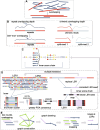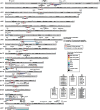NextDenovo: an efficient error correction and accurate assembly tool for noisy long reads
- PMID: 38671502
- PMCID: PMC11046930
- DOI: 10.1186/s13059-024-03252-4
NextDenovo: an efficient error correction and accurate assembly tool for noisy long reads
Abstract
Long-read sequencing data, particularly those derived from the Oxford Nanopore sequencing platform, tend to exhibit high error rates. Here, we present NextDenovo, an efficient error correction and assembly tool for noisy long reads, which achieves a high level of accuracy in genome assembly. We apply NextDenovo to assemble 35 diverse human genomes from around the world using Nanopore long-read data. These genomes allow us to identify the landscape of segmental duplication and gene copy number variation in modern human populations. The use of NextDenovo should pave the way for population-scale long-read assembly using Nanopore long-read data.
Keywords: Error-correction; Genome assembly; Human genomes; Long reads; Segmental duplication.
© 2024. The Author(s).
Conflict of interest statement
De-Peng Wang is the chief executive officer of GrandOmics Biosciences Company. Jiang Hu, Zhuo Wang, Zongyi Sun, Fan Liang, and Jingjin Li are employees of GrandOmics Biosciences Company. The remaining authors have no conflicts of interest to declare.
Figures



References
-
- Nurk S, Walenz BP, Rhie A, Vollger MR, Logsdon GA, Grothe R, Miga KH, Eichler EE, Phillippy AM, Koren S. HiCanu: accurate assembly of segmental duplications, satellites, and allelic variants from high-fidelity long reads. Genome Res. 2020;30:1291–1305. doi: 10.1101/gr.263566.120. - DOI - PMC - PubMed
Publication types
MeSH terms
LinkOut - more resources
Full Text Sources

